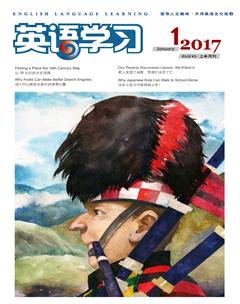以19世纪的方式找路
By+Sue+Wunder
A radio report caught my attention the other day, as it spoke straight to my heart: Cadets1 at the US Naval Academy in Annapolis, Md., are now required to revisit and potentially revive the ancient skill of steering a ship by the stars.
By the stars—imagine that: looking up at the sky, not down at a screen, so many years after the heavens critical role in guiding mariners has fallen by the wayside,2 first displaced by radio waves, then by modern GPS. Much is gained—but something also lost—in such progress, I think.
Chalk it up to my love of 18th- and 19th-century seafaring tales (reading them is one of my coping mechanisms for life in the landlocked Midwest), when sailors had only celestial maps for navigation and still miraculously managed to sail the planets vast oceans and even circumnavigate the globe.3
Recent cybersecurity concerns have triggered renewed interest in backup navigational strategies such as stargazing, and simple hand-held technologies like the sextant, so often invoked in Richard Henry Danas Two Years Before the Mast, a tale that chronicles a mid-19th-century merchant ships endlessly harrowing voyage from Boston to California and back.4
I wouldnt wish the harsh conditions of that trip on modern sailors, but I am all for anything that gets people clued in to their compass bearings and travel trajectories without high-tech and often mindless guidance.5
“Is that north or south of here?” Ive asked motel clerks and gas station attendants about a particular address Im seeking in my GPS-less travels.
“Well, its that way,” comes the most frequent reply, accompanied by a pointed finger, and I realize that north, south, east, and west are not familiar coordinates to many people otherwise thoroughly attuned to the local lay of their land.6
To be fair, I havent always been attuned to compass points either. In fact it was not until I was a young adult, lazing on a float in my parents pool on a late summers visit home, and watching the sun dip below the roofline—with a chilling shadow sliding across the water—that I first realized that my childhood home faced due west7. It struck me as odd at the time that Id been oblivious8 to this simple fact, especially since Id begun to be schooled in geology and certainly in compass work. But like so many, Id grown up thinking and navigating in terms of other coordinates, based on familiar streets, rights and lefts, and reference points such as my school, the homes of friends, the nearest playground, and the local shopping plaza.
One day, when a car pulled alongside me on my small bike and the driver asked for directions to a Rochester, N.Y., landmark, I told him to drive to Kathys house, turn left, and then turn right at my school, and so forth. He smiled wanly, tipped his hat,9 and drove on to more helpful directions, one hopes.
All the while, the sun moved overhead in the deeply familiar curvature10 I never fully attended.
Ive long since become accustomed to finding my bearings on travels in unfamiliar territory11 by the suns position. And now Id love to sit in on a class at the academy to learn to navigate by the moon and stars. Its a skill Ill likely never need to draw upon. Yet just knowing how it would connect me, in a new and profound way, to the historical arc of human experience on this planet.
As for modern sailors, it might just bring them safely home one day, if all else fails.
有一天,一則电台报道引起了我的注意,报道内容正合我意:位于安纳波利斯的美国海军学院的学员们现今被要求得重新研究并可能恢复一项古老的航海术,即用观星的方法为船只指引方向。
观星导航——想象一下:我们终于又要仰望天空,而不是低头看屏幕了。这么多年来,天空在导航中的重要性逐渐衰落,先是被无线电波取代,继而又被现代全球定位系统超越。这样快速的进步中,我们得到了很多,但我想,也失去了很多。
之所以这样想,大概是因为喜欢十八九世纪的航海故事吧(身处内陆的美国中西部,我就靠这些故事神游海洋)。那时,船员只能靠天体图定位,却依然能奇迹般地穿越广袤的海洋,甚至环球航行。
近来对网络安全的担忧让人们重新开始关注可以替代现有科技的航海策略,比如观星,或者六分仪之类简单的手持器械。六分仪在理查德·亨利·达纳的《航海两年》里的戏份可不少。这本书讲述了19世纪中期,在往返于波士顿和加利福尼亚之间的商船上所发生的种种可怕的故事。
我倒不希望现代船员回到那么艰苦的条件,只是赞同和支持他们在没有高科技时还可以借助罗盘指针和航行线路来定位,而不至于抓了瞎。
“这个地方是在这儿的北边还是南边?”一次出门,我因为没带导航,只好向汽车旅馆服务员和加油站工作人员这样打听某个地方。
“喏,就是那边。”通常他们这样回答,然后用手一指。由此我意识到,很多人都不熟悉东西南北这样的方位坐标,除非他们对当地的情况了如指掌。
老实说,我也并非从一开始就熟悉罗盘上的方向标度。说起来,我也是直到成年后才第一次注意到儿时的家是正西朝向的。那是夏末回父母家的时候,我躺在游泳池的充气游泳垫上,看着太阳落下屋檐,在水面投下寒冷的阴影,突然意识到这个问题。当时感觉很奇怪,这么简单的事实,我竟然一直视而不见,况且那会儿我已经学了地理,对罗盘肯定也有所了解。我和大多数人一样,从小就靠其他坐标来辨认方向,比如熟悉的街道,左手边和右手边,还有学校、朋友的家、最近的游乐场、当地的商场等作为参照物。
一天,一辆车停在了我的小小自行车旁,司机问我纽约州罗切斯特市的一个地标怎么去。我告诉他先开到凯西的家,左转,到我的学校之后右转,诸如此类的。他无力地笑了笑,提了下帽檐,开车去找更有用的帮助了,但愿他能找到。
就在那时,头顶的太阳沿着熟悉的轨迹移动着,而我却从未注意过。
我早已习惯在不熟悉的地方,通过太阳的方位来辨认方向。而现在,我想回到课堂,学习靠月亮和星星导航。这项技能我可能永远也用不到,但是通过它,我可以以一种崭新而深刻的方式,和这座星球上人类的历史轨迹联系起来。
而对现代的船员来说,万一其他方法都不管用了,这项技能起码可以把他们安全地带回家。

